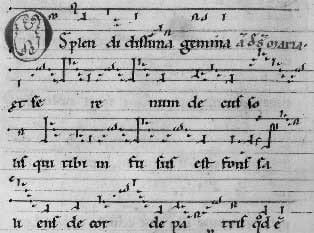
I should make it clear from the outset that while I am not attempting to make new claims about Hildegard’s own experiences of illness or the authenticity of the works that have been attributed to her oeuvre, this literature has played an important part in informing this piece each of these three questions has their own independent scholarly history, but they converged in Singer’s argument.

This grapples (among other themes) with whether Hildegard suffered from migraine, whether she was the designer of the Scivias illuminations, and whether she was the author of the medical text Causae et Curae. There is a large scholarly output in English, German and French by historians specialising in Hildegardian studies. More recently, on the internet, contributors to blogs and websites have freely proposed Hildegard as a ‘patron saint’ of migraine and migraineurs. Hildegard’s migraine has appeared in some significant places, including Oliver Sacks’ Migraine (1970), scholarly publications in medieval history and a pharmaceutical marketing campaign. Nevertheless, Singer’s retrospective diagnosis of Hildegard’s migraine has persisted, gaining popularity in the late twentieth century as the abbess’ reputation has grown. 1 Nearly a century later, medical ideas about migraine have changed a great deal. Noting that Hildegard had admitted to long periods of illness, Singer diagnosed a functional nervous disorder, specifically migraine. In the stars, shimmering points of light and crenellated figures of some of the 35 illuminations in Scivias, Singer thought that he recognised depictions of ‘scintillating scotoma’. In Wiesbaden, he consulted the twelfth-century illuminated Scivias manuscript (c.1165) which described 26 religious visions experienced by the celebrated St Rupertsberg abbess, Hildegard of Bingen (1098–1179). In 1913, a young scientist and historian named Charles Singer was in Germany researching precursors to modern theories of contagion. The case of Hildegard’s migraine reminds us of the need to historicise scientific evidence just as rigorously as we historicise our other material and it exposes the cumulative methodological problems that can occur when historians use science, and scientists use history on a casual basis. This article first traces the emergence of a new formulation of migraine in the nineteenth century, then shows how this context enabled Singer to retrospectively diagnose Hildegard’s migraine and finally examines some of the ways in which this idea has gained popular and academic currency in the second half of the twentieth century. It argues that simply championing or rejecting retrospective diagnosis is not enough that we need instead to appreciate how, at the moment of creation, a diagnosis reflects the significance of particular medical signs and theories in historical context and how, when and why such diagnoses can come to do meaningful work when subsequently mobilised as scientific ‘fact’. This article uses Hildegard as a case study to shift our focus from a polarised debate about the merits or otherwise of retrospective diagnosis, to examine instead what happens when diagnoses take on lives of their own. Hildegard, Eibingen, Johannes Berchmans Göschl, Sr.Charles Singer’s retrospective diagnosis of Hildegard of Bingen as a migraine sufferer, first made in 1913, has become commonly accepted. Hildegard von Bingen, Schola der Benediktierinnenabtei St. "O Vis Aeternitatis": Vespers in der Abtei St. Symphony of The Harmony of Celestial Revelations: The Complete Hildegard von Bingen, Volume 1ġ1,000 Virgins: Chants for the Feast of St. Symphony of the Harmony of Celestial Revelations: The Complete Hildegard von Bingen, Volume 1 (Sinfonye) Hildegard von Bingen Oxford Camerata, Jeremy Summerly Heavenly Revelations: Hymns / Sequences / Antiphons / Responds

Vision: The Music of Hildegard von Bingen Zum Fest der Heiligen Hildegard von Bingen (Schola und Chor der Benediktinerinnenabtei St Hildegard, Eibingen) Abbess Hildegard of Bingen Gothic Voices, Christopher Page, Emma Kirkby


 0 kommentar(er)
0 kommentar(er)
